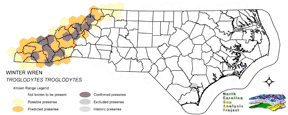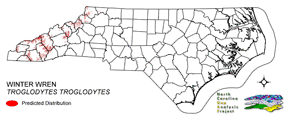
| Taxa: |
| Order: |
| Family: |
| Aves |
| Passeriformes |
| Troglodytidae |
| NatureServe Global Rank: |
| NatureServe State (NC) Rank: |
| G5 |
| S3B,S5N |
| Federal Status: |
| NC State Status: |
| --- |
| --- |


| Land Unit |
| US Fish & Wildlife Service |
| US Forest Service |
| US National Park Service |
| US Department of Defense |
| NC State Parks |
| NC University System |
| NC Wildlife Res. Com. |
| NC Forest Service |
| NC Div. of Coastal Mgmt. |
| Local Governments |
| Non-Governmental Org. |
| Other Public Lands |
| Private Lands |
| GAP Status 1-2 |
| All Protected Lands |
| Statewide |
| Hectares |
| 0.00 |
| 55,542.15 |
| 0.00 |
| 32,177.70 |
| 526.95 |
| 13.05 |
| 742.32 |
| 0.12 |
| 0.00 |
| 2,291.13 |
| 2,732.58 |
| 0.00 |
| 68,482.35 |
| 44,160.15 |
| 93,994.23 |
| 162,508.35 |
| Acres |
| 0.00 |
| 137,247.61 |
| 0.00 |
| 79,512.81 |
| 1,302.12 |
| 32.25 |
| 1,834.31 |
| 0.89 |
| 0.00 |
| 5,661.50 |
| 6,752.35 |
| 0.00 |
| 169,223.54 |
| 109,122.68 |
| 232,265.35 |
| 401,567.39 |
| % of Dist. on |
| Prot. Lands |
| 0.0 % |
| 59.1 % |
| 0.0 % |
| 34.2 % |
| 0.6 % |
| < 0.1 % |
| 0.8 % |
| < 0.1 % |
| 0.0 % |
| 2.9 % |
| 2.9 % |
| 0.0 % |
| 0.0 % |
| 47.0 % |
| ----- |
| ----- |
| % of Dist. on |
| All Lands |
| 0.0 % |
| 34.2 % |
| 0.0 % |
| 19.8 % |
| 0.3 % |
| < 0.1 % |
| 0.5 % |
| < 0.1 % |
| 0.0 % |
| 1.4 % |
| 1.7 % |
| 0.0 % |
| 42.1 % |
| 27.2 % |
| ----- |
| ----- |
|
Fairly common in the high elevations of the mountains (Alsop 1991). Nests locally in dense shrubby understory of northern hardwood and spruce-fir forests, in early successional communities, and in heath balds (Alsop 1991, Simpson 1992), often near water (Kaufman 1996). An important habitat feature may be the presence of decaying stumps, downed logs, and upturned roots, which are used for nesting and foraging (Bent 1948). Nests in any type of cavity or crevice, usually less than 6 feet from the ground, including crevices in the roots of upturned logs, holes in stumps, old woodpecker holes, rock crevices, holes in streambanks, or spaces under cabin porches. Forages on the ground and low in vegetation. Will also take food items from the surface of water (Kaufman 1996), immersing entire head in the process (Ehrlich et al. 1988). NATURE SERVE GLOBAL HABITAT COMMENTS: Coniferous forest, primarily with dense understory and near water, and in open areas with low cover along rocky coasts, cliffs, islands, or high mtn. areas, logged areas with large amounts of slash; in winter and migration also in deciduous woods with understory, thickets, brushy fields. Nests in various sorts of hollows, cavities, and holes, most often on side of tree, wall, or steep bank, to height of about 3 m. |
| Code | Name | Description | NC Natural Heritage Program Equivalent |
| 521 | Spruce/Fir Forest | High Elevation Frazer-Fir - Red Spruce, Red Spruce and Red-Spruce-Yellow Birch Forests. Tree densities included here include both woodland to forest density. Highly intermixed with Northern Hardwoods, Grassy Balds, and Shrub Balds. | Red Spruce--Fraser Fir Forest, Fraser Fir Forest |
| 522 | Northern Hardwoods | High Elevation forests including yellow birch, American beech, and yellow buckeye. Includes forests with Hemlock and Yellow Birch. | Northern Hardwoods Forest, Boulderfield Forest |
| 526 | Appalachian Cove Forest | Mixed Mesophytic forests of the mountains. Includes tuliptree, basswood, yellow buckeye and surgar maple. This class is mapped to include cove forests dominated or co-dominated by hemlock. | Rich Cove Forest, Acidic Cove Forest |
| 527 | Appalachian Hemlock | Upland hemlock forests of the moutains region. Vary from side slopes to steep slope positions. | Canada Hemlock Forest |
|
Bent, A.C. 1948. Life histories of North American nuthatches, wrens, thrashers, and their allies. U.S. National Museum Bulletin 195. Washington, D.C.
Simpson MB Jr. 1992. Birds of the Blue Ridge Mountains. Chapel Hill and London: University of North Carolina Press. Kaufman K. 1996. Lives of North American Birds. Boston, New York: Houghton Mifflin Company. Harrison, C. 1978. A field guide to the nests, eggs and nestlings of North American birds. Collins, Cleveland, Ohio. Harrison, H.H. 1979. A field guide to western birds' nests. Houghton Mifflin Company, Boston. 279 pp. Terres, J.K. 1980. The Audubon Society encyclopedia of North American birds. Alfred A. Knopf, New York. American Ornithologists' Union (AOU), Committee on Classification and Nomenclature. 1983. Check-list of North American Birds. Sixth Edition. American Ornithologists' Union, Allen Press, Inc., Lawrence, Kansas. Ehrlich, P.R., D.S. Dobkin, and D. Wheye. 1988. The birder's handbook:a field guide to the natural history of North American birds. Simon and Shuster, Inc., New York. xxx + 785 pp. Allen, Ethel R. 1977. Proposed Wildlife Management Plan for Suggs Millpond and Adjacent Carolina Bays. Sibley, C.G., and B.L. Monroe. 1990. Distribution and taxonomy of birds of the world. Yale University Press, New Haven, Connecticut. xxiv + 1111 pp. Alsop FJ III. 1991. Birds of the Smokies. Gatlinburg: Great Smoky Mountains Natural History Association. |
For more information please contact them at:
NC-GAP Analysis Project
Dept. of Zoology, NCSU
Campus Box 7617
Raleigh, NC 27695-7617
(919) 513-2853
www.basic.ncsu.edu/ncgap